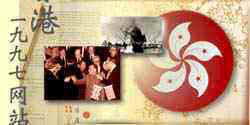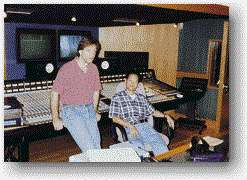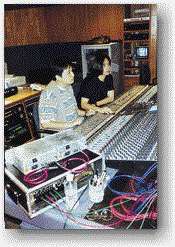Hong
Kong truly sits at the crossroads of two major cultures. Since its historical
origins over 150 years ago as a friction point for the infamous Opium Wars
between mainland China and the British Empire, this small territory has assumed
a dramatic importance far beyond its geography. The region is now living through
a 50-year moratorium following its formal handing back to China in July 1997;
during the next half century, the enigmatic Communist Chinese regime is expected
to show its true intentions for this outpost of rampant capitalism so close to
its shores.
According to Robert Porter, an expatriate Canadian now
working as chief engineer at Q-Sound Studio in Kowloon, "Although
the market for locally-produced music in Hong Kong is small, with modest budgets, we see a
lot of sessions for local and Taiwan-based artists." A good-selling local album might
ship between 25,000 and 50,000 units, Porter says, "while a major hit might move
between 500,000 and a million." The facility also attracts clients from Japan,
Singapore and Malaysia. The studio complex features three control rooms located on two floors of an apartment building off one of the busy thoroughfares in downtown Kowloon. (It seems that the city of Hong Kong has far less stringent zoning laws that the majority of America cities. With space at a premium, and escalating real-estate costs, a number of prominent studios are to be found in such locations.) Room A features an SSL SL-4048 G-Plus console with Total Recall; Room B, a Raindirk Symphony II with Optifile Tetra automation; and Room C, a 64-input Otari Concept I with Eagle automation. Clients have a choice of Sony PCM-3324/3348 digital and Otari MX-80 analog multitracks. Small overdub and vocal booths are also featured. Acoustic design for all three studios was by Roger Quested. Monitoring is provided by Quested Q210/QSB212 active four-way systems in Room A, H2120 three-way systems in B and Quested H208s in C. Room booking rates range from HK$880 per hour (around US$110) for Rooms B and C, to HK$1,330/hour (US$166) for the flagship Room A, including a session engineer, digital multitrack and a full collection of outboards. A unique aspect of music recorded at a number of Hong Kong facilities, Porter says, stems from the musicality of the local Cantonese language. (Mandarin is the primary language on mainland China.) "Often we will be booked to record the background melody," he explains, "and then the tapes will be turned over to a lyricist." Because the Chinese language is so tonal, it is vital that the lyrics blend harmonically with the melody. All of which means that the choice of words, and their meaning, is secondary to their blending seamlessly with the music. "We use a lot of pick-up bands, keyboard players and background singers for these types of dates," the engineer says. "A lot of the time, the basic tracks will be written at a home studio, and then the producer will come in here to record the background vocals or chorus with, usually, two men and two women. Then when the lyrics have been written - we often receive them here via fax - the featured artist will return to the studio with an arranger, who will coach the artist to achieve the required harmonic balance. "We use Pro Tools to touch up and comp these vocal tracks - sometimes line by line - to ensure a seamless production." Albums often just comprise a collection of songs, with no overall theme. To achieve a fast turnaround, Porter concedes, "Most current productions are tracked against a click track or MIDI sequence, and are often pretty structured." Because of limited budgets, an entire album might be completed in around 300 hours of studio time, including mixing. "Compared to an American session, where the producer is 'God,' and normally controls everything, here in Hong Kong the artist is Top Dog." While some local producers are in charge of all aspects of a production, "most are working for the record company; the label chooses the songs and the arranger," Porter offers. "As a result, the artist often takes control of a session, and is backed by the label. "And because of the emphasis on harmony of the lyrics, and how they bend with the music - rather than what they mean - vocalists are considered stars of a production, not necessarily just the singer. In many ways, the scene here - with its emphasis on the artist, the song and the arrangement - is more like Nashville, than Los Angeles or New York." Q-Sound has also seen sessions with a number of Western acts, including Peter Gabriel, who stopped in during a world tour a couple of years ago to record vocals to "Summertime," for George Martin's tribute album, "The Glory of Gershwin" with Larry Alder.
Avon Studios, a stone's throw away from Q-Sound, features three control rooms laid out on two adjoining floors of a 15-story commercial building. The facility handles a cross section of clients from Hong Kong (Polygram, Warner Bros. and Cine Poly are local labels that book the facility on a regular basis), Taiwan (Rock Records) and Japan. Designed in the early Eighties by acoustician Tom Hidley, the facility was purpose-built for CBS-Sony; its current owners, the Chiu family, purchased the complex some three years ago. (And Avon is probably unique by Hong Kong standards, in that it was purpose-built during the building's original construction; the majority of other facilities are conversions.) Room rates, which include a staff engineer, digital multitrack and outboards, extend from HK$650 per hour (around US$80) for Studio C to HK$1,500/hour (US$185) for Studio A. The flagship Studio A houses a 48-channel SSL SL-9000 J-Series with Total Recall automation; a companion live area provides 670 square feet of flexible tracking/overdub space. Studio B is designed primarily for remix, and features a 48-channel AMS Neve VR Series console with SSL Total Recall. Both rooms offer TAD monitoring systems. Studio C is intended for mastering plus analog 24-track overdubs; hardware includes a vintage MCI JH-600 console and a full Sonic Solutions workstation rig. A new room, with design by Sam Toyoshima and equipped with an SSL SL-4058 G+, is scheduled to be completed during early 2004. All rooms come complete with an in-house engineer and a wide selection of outboards. According to Avon's General Manager, Brian Choy, "The acoustics in Studio A and B are carefully matched, so that projects can track in one room and then mix in the other. And our new room will mean that Avon is the only Hong Kong facility to offer three 48-track rooms, with full tracking and mixing flexibility. "The majority of our sessions - some 80 % - [involve] both tracking and mixing here, a trend that is increasing. Our specialty, if you like, is to provide a combination of good acoustics - so that artists can record in a live-sounding environment - with the best equipment around. Our live areas feature tall ceilings, with plenty of trapping to contain the sound. We consider that we offer something for everybody that comes to Avon Studios." Tang Lou Studios, located across the harbor from Kowloon on the island of Hong Kong in Wanchai, offers two rooms on two floors of a commercial building. The first-floor Studio, built in 1993 with design by British acoustician Keith Slaughter, houses a 56-channel SSL SL-4056 G-Plus with Ultimation moving-fader automation. A companion tracking area features high ceilings and variable acoustics. Studio TL22, constructed in 1995 on an upper floor, with wonderful views across the Hong Kong harbor, features a 32-channel Otari Concept 1 with DiskMix moving-fader automation. A variety of analog and digital multitracks are available, including Sony PCM-3324 and -3348 DASH-format systems, as well as Otari MTR-90 MkIII 24-track and Sony APR-5002 mastering transports. Monitoring systems comprise a Quested Model 212 three-way active system in Studio 1, and an Quested H208 system in #2. Room charges range from HK$900 (around US$110) per hour for Studio 2, to HK$1,650/hour (US$205) for the Studio 1, including second engineer, digital multitrack and outboards. "Most of our sessions are for record labels," says Ky Yuen, Tang Lou's Studio Manager, "with the remaining 10% coming from jingles, commercials, and soundtracks. And about half of our music sessions come from Taiwan-based labels, plus local acts." Sessions will also involve recording lyrics in different languages - maybe Cantonese, Taiwanese and Mandarin - against a common music track. "Our new business is coming from producers and record-company [staff] that are looking for somewhere a little different. And we maintain good relationships with our in-house and freelance engineers, who are also responsible for spreading the word about our facility." "The majority of acts comprise solo artists," Yuen says, with few bands or ensembles. The Asian taste, it would seem, is for simple lyrics sung by a solo artist; with few exceptions, Western-style bands do not find favor with locals. Tang Lou also handles an increasing amount of vocal overdubs and remixes in both rooms. "Often a producer or artist will start a project in an ADAT-equipped room, or with a MIDI/sequencer production, and then bring the tapes in here for overdubs and the mix." And yes, Hong Kong is very much a niche market. Here,
because of the language differences, and the impact of Western cultures, Yuen estimates
that an album can make a good profit from sales of around 100,000 units. "In Taiwan,
sales of 600,000 would put the album at the top of the local charts." For more information:
|


